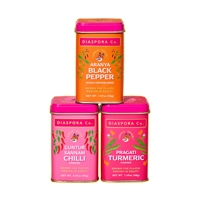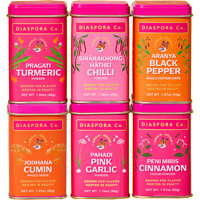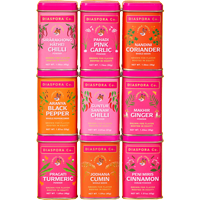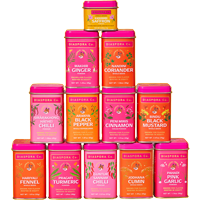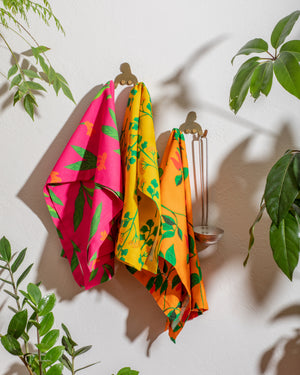Design enthusiast and perfumer Jahnvi Lakhota Nandan’s 2017 book, Pukka Indian: 100 Objects That Define India, is a quirky catalogue of curious prototypes of Indian design. It features a hundred objects peculiar to the Indian way of life. These range from quotidian objects found around Indian homes to items of cultural or historical significance, and even anachronisms that remain relevant because of their nostalgic quality. Take for instance, the lota, a small, scooped-neck water pot typically made of copper or brass, or datun, neem twigs used as teeth-cleaning chew sticks, still popular in rural India. The Hindustan Ambassador car that went out of production in 2014 rubs shoulders with Chyawanprash, a jam-like dietary supplement with roots in Ayurveda. In essence, these are things defined by their Indianness. One among these items is the masala dabba, or the quintessential Indian spice box.
The standard masala dabba, found in most Indian kitchens, is an unassuming, flat, steel canister with a lid. Inside, seven small circular containers, set in a floral arrangement, hold different spices. On the surface, there’s nothing remarkable about it. But once the top comes off, the masala dabba reveals a heady paroxysm of colours and aromas.
On most days, in an ordinary Indian kitchen, the aesthetics of the masala dabba go unnoticed. Its treatment is unceremonious, almost offhand. This apparent nonchalance, however, stems not from irreverence, but instead a deep sense of intimacy and comfort bred by familiarity. The masala dabba is, after all, the sine qua non of everyday cooking in kitchens across the country. Lifting the lid off the masala dabba is often the starting point for every meal turned out of an Indian kitchen — whether mundane or memorable.
![]()
Spice boxes are not exclusive to India. They have existed in some form or the other in many cultures. In Jewish tradition, for instance, an ornate spice box (also referred to as a spice tower) is filled with spices and passed around during Havdalah, a ritual that marks the end of Shabbat. The fragrance of the spices is inhaled to mark the transition between the holy period and ordinary life. In the colonial era, spice boxes also became popular in Europe and its colonies, as a result of the burgeoning global spice trade. They served not only as coffers for expensive spices, but also veritable status symbols. At feasts across Europe, a seat near the spice box was considered the seat of honour, writes J Clinton Cunningham in Products of the Empire (1921).
On the other hand, Renaissance Europe’s cabinets of curiosity, museums and private collections displayed a mind-boggling collection of ornamental Indian spice boxes. Made of solid gold, silver, brass, cast iron and other materials; inlaid with ivory or damascened in gold or silver; enamelled, filigreed or encrusted with precious gems, these were displayed as exotic specimens of Indian artistry, according to The British Empire: A Historical Encyclopaedia.
Craft-based industries in India also indulged the colonizers’ demand for exotic artefacts. The braziers of Ahmedabad for instance, made “small boxes of very graceful form and covered with the most delicate tracery that were known to Europeans as spice boxes,” writes George Birdwood, in his 1884 book, The Industrial Arts of India.
In colonial America, as in Europe, those who could afford to buy spices got spice boxes built to order. Take for instance, the Pennsylvania spice boxes — miniature cabinets with multiple drawers and compartments behind sturdy, paneled doors — that were specially designed to store spices that were akin to precious jewels. Modelled on English spice boxes, these even came with ingenious secret chambers to hide special seasonings. (There is even a whole book written just on these boxes).
While spice boxes in the West were primarily used to store spices, the seasoning boxes, popular in Victorian England, were closer to the Indian masala dabba. Emma Kay, in her book Vintage Kitchenalia, writes: “These were cited in essential equipment lists for the kitchen by celebrity chefs of the day such as Alexis Soyer and Charles Francatelli. Seasoning boxes were often cast as hinged, lidded tray compartments, on centre pivot, for cooks to easily access the appropriate herbs and spices needed during cooking.”
![]()
However, it’s only in the Indian domestic kitchen that one witnesses such a prolific and single-minded use of a spice box in the culinary process, daily, over centuries. The masala dabba, a veritable icon of domesticity, is not reserved for special spices. Instead, it is meant for essentials that go into every meal turned out of an Indian kitchen. Its indispensability rides primarily on utility and convenience.
Nandan calls the masala dabba, “a fine example of ergonomic design, apt for the Indian kitchen, domestic practices and cooking styles.” Elevated kitchen platforms and counter-top cooking are fairly recent in India, dating back perhaps to the 1960s when LPG cylinders were introduced in the country. Traditionally, cooking happened on kitchen floors and in open courtyards, often on charcoal-fueled clay ovens or kerosene stoves. Cooks would typically sit on the ground to prepare meals – a practice still prevalent in parts of rural India. Moreover, most households had a separate storeroom where grains and spices would be stocked in large quantities, often for an entire year.
“In [the state of] Gujarat, for instance, pounding fresh spices and packaging them for the whole year is still a cherished summer tradition,” says culinary consultant Rushina Munshaw Ghildiyal, who has been documenting spice stories from across the country through her project Spice Chronicles with RMG. A masala dabba was therefore a clever, coherent solution for organizing essential spices in one compact, portable case for daily use. “It saves time, effort and the frustration of discovering the turmeric missing just when you need it,” says Ghildiyal.
Indian regional cuisines (barring a few) depend heavily on spices.
Most Indian dishes require several spices that are often added in a particular sequence and at different stages in the cooking process. Timing is crucial. This is where the structure of the masala dabba comes in handy. “The open display of spices in a masala dabba allows quick thinking and decision-making, while aiding culinary creativity,” says Nandan.
“Besides, as active users of spice, we know that spices can lose flavour and potency with exposure,” adds culinary consultant and cookbook author Saee Koranne-Khandekar, a champion of the cuisines of Maharashtra, her native state in western India. “The masala dabba allowed one to take out small portions of spices that could be refilled frequently.”
Khandekar organizes her spices in two separate spice boxes. "One holds the phodni spices (or spices used for tempering) — mustard seeds, cumin seeds, asafoetida, turmeric, urad dal (black lentils) and dried red chilies. These are the base, and in many cases, the finish for a Maharashtrian dish. This dabba is used with particular care and reverence,” says Khandekar. The second contains powdered spices — turmeric, red chili, garam masala and goda masala, a spice mix comprising coriander, cumin, fenugreek, cinnamon, sesame and dried coconut, commonly used in Maharashtrian food.
The Indian masala dabba didn’t always have seven compartments. "Interestingly, in Tamil, the masala dabba is called Anjarai Petti, which literally translates to five-compartment box. The early spice boxes of the region perhaps had five recesses, instead of seven as has become norm these days, primarily used to keep whole spices for tempering, including lentils like urad and chana dal,” food writer Ammini Ramachandran tells me.
![]()
It’s clear that the masala dabba fit seamlessly into the creative process of Indian cookery. Even as Indian kitchens modernized, it is by virtue of its multifaceted utilitarian value that masala dabbas remained relevant. For one, they ensured that kitchen counters were not crowded with numerous spice jars. They also became an ergonomic and space-saving choice in small urban kitchens. “The classic steel masala dabbas that most homes use today are light, stackable, handy and easy to clean,” says Ghildiyal.
But these sleek, stainless-steel masala dabbas are a fairly recent addition to Indian kitchens. “Stainless steel became fashionable, and soon indispensable, in the Indian kitchens only in the 1950s and 60s,” says Nandan. “It must only be then that the masala dabba adopted the new material.” According to Nandan, the earliest spice boxes were perhaps wooden. “Traditionally these boxes were carved by slicing out a piece of trunk from a single tree with multiple recesses, the size of a drinking glass, to hold different spices. Moisture filters through the wood naturally while allowing the contents to breathe,” she writes in her book. In humid regions, especially in southern India, wooden spice boxes were the preferred choice.
In addition to wood, metals like brass, cast iron and copper were also used extensively in making masala dabbas. They came in different sizes and exciting shapes – circular, square, octagonal or hexagonal – often adorned with intricate carvings and etched patterns. Traditional masala dabbas were often fine specimens of regional artistry and craftsmanship — heirlooms passed down through generations. Nowadays, these vintage spice boxes mostly add accents to living rooms and oomph to Instagram feeds.
![]()
However similar masala dabbas may look, their essence lies in the masalas they hold. In that sense, no two masala dabbas can ever be identical. Regional cuisines in India have diverse flavour profiles, every home its distinct palate, and every cook their individual preferences — all of which reflects in the composition of a masala dabba.
“I find it particularly interesting how the masala dabba reveals so much about one’s culinary heritage,” says Khandekar. “For instance, the urad dal in my spice box — unusual for a Marathi kitchen — is a hat tip to my south Indian connection,” she adds. In my own household, the quintessentially Bengali panch phoran in my Punjabi mother-in-law’s masala dabba, with its ajwain (carom seeds), dhania (coriander seeds) and homemade garam masala powder, tells the story of migration and adaptation, and of culinary exchange and evolution.
The Indian domestic kitchen is a predominantly gendered space – often circumscribed by codes of female fellowship that transcend generations. This culinary wisdom, usually handed down matrilineally, sometimes takes the form of a masala dabba. In some communities, a spice box would traditionally be a part of bridal trousseau – a trusted aide in the unfamiliar surroundings of a new kitchen in a new home. “The day after my engagement, my maternal grandmother took me to the utensil shop my family has been buying from for generations, to get me my very own masala no dabbo. She had it engraved with my name,” says Ghildiyal. “It was a rite of passage.”
For others still, the spice box is a reminder of home and identity. In her home in a remote town of Western Australia, far from her Kashmiri roots, spice connoisseur Sarina Kamini, for instance, finds comfort in her masala dabbas.
“As a part of the great dispersal that is the diaspora, my masala dabbas keep me rooted in my culture,” she says.
“For me, the masala dabba is my way of carrying my home wherever I go.” It is safe to say that even if functionality is at the heart of the masala dabba, it is in its capacity as an artefact of cultural expression and a repository of memories, stories, and sentiments, that the masala dabba demonstrates its true significance.







